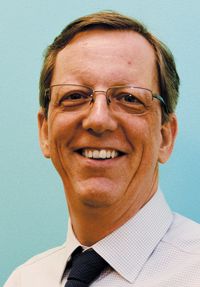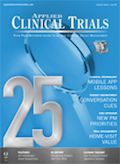Partnership Focuses on Layperson Understanding of Clinical Study Results
Q&A explores the implementation of the Trial Results Summaries Portal and the goals of the layperson summary program.
Earlier this year, TrialScope launched its Trial Results Summaries Portal, www.trialsummaries.com, with information from its first partner, AstraZeneca. The portal is a publicly accessible, sponsor-agnostic, unbiased website for people looking to read clinical trial result summaries in layperson, easy-to-understand language. Applied Clinical Trials spoke with Thomas Wicks, TrialScope’s chief strategy officer, and Julie Holtzople, clinical trial transparency operations director for AstraZeneca, about the portal’s implementation and the goals of the layperson summary program.
Q:How did the Trial Results Summaries Portal come about?
WICKS: There has been more industry direction on communicating clinical trial results summaries to
Thomas Wicks

participants that are written in consideration to their level of understanding. Organizations such as MRCT, TransCelerate and CISCRP agree that the information be intelligible but not promotional. We felt that establishing a separate site, with no competitive influences, or implicit endorsement would fulfill that requirement. Sponsors could put their summaries on their website, but that in and of itself could be construed as promotional.
HOLTZOPLE: TrialScope already supports AstraZeneca with the work we do to register clinical trials and post clinical trial results. The partnership for publication of trial results summaries was a natural extension to this.
Q:How long has AstraZeneca been working on its lay summary program?
HOLTZOPLE: In 2015, we took the step to provide trial results summaries, also known in the EU as lay language summaries, to all patients that participate in an AstraZeneca-sponsored clinical trial-and to provide this in the same language as their signed informed
Julie Holtzople

consent form. This new portal provides a simple and improved way for patients to be able to access the information, and to deliver on this commitment in a way that study participants find useful.
Q:What has the feedback from participants been to date?
HOLTZOPLE: Study participants and patient advocate feedback was key in helping us develop the website, and we have been able to incorporate their feedback in the design. We have heard requests from patients who hope this portal becomes a standard industry tool. Patients also tell us they are speaking with other sponsors whose trials they are involved in, hoping they will also commit to using this tool to return trial result summaries.
Q:What are the regulatory requirements for lay summaries?
WICKS: The FDA has no requirement. Sponsors are required to report clinical trial results in ClinicalTrials.gov. But that information is very scientific and data driven, difficult for even the most informed person to understand.
The EMA (European Medicines Agency) has a portal also for results, but that is not intended for participants. Part of the EMA’s new clinical trial directive calls for layperson summaries be in effect later in 2018, and it intends to host its own portal for those summaries.
Q:Do you think sponsors will just use the EMA portal when it’s available because it’s required?
WICKS: I don’t think so. The EMA requirement is only for summaries for trials conducted in the EU. So sponsors that want to get that information out to the public, would be limiting themselves. I think they will put them in both portals.
Q:How much do the regulatory authorities affect AstraZeneca’s decision to move toward transparency?
HOLTZOPLE: AstraZeneca has a long-standing commitment to making information about our clinical research publicly available, while safeguarding patient privacy. We believe that transparency enhances the scientific understanding of how our medicines work and is in the medical interest of patients.
In many cases, we go beyond the minimum standards required by regulatory authorities, and-as with this new trial results summaries portal-we continue to explore the best ways to make information about our trials available, working alongside others in the industry to do so.
Q:How will TrialScope populate the Trials Results Summaries Portal?
WICKS: We are in discussion with many pharmaceutical companies, and plan to make announcements soon. Interestingly, we are receiving a lot of queries from academics-institutions and teaching hospitals-about the summaries. If an academic receives a grant from the government, it must post its protocol and results to ClinicalTrials.gov, just like the industry does.
But, again, there is no legal requirement in the U.S. for layperson summaries. But we see a definite push for transparency. Ethically, it’s the right thing to do.

Improving Relationships and Diversifying the Site Selection Process
April 17th 2025In this episode of the Applied Clinical Trials Podcast, Liz Beatty, co-founder and chief strategy officer, Inato, discusses a number of topics around site engagement including community-based sites, the role of technology in improving site/sponsor relationships, how increased operational costs are impacting the industry, and more.
Behind the Buzz: Why Clinical Research Leaders Flock to SCOPE Summit
February 7th 2025In this episode, we meet with Micah Lieberman, Executive Conference Director for SCOPE Summit (Summit for Clinical Ops Executives) at Cambridge Innovation Institute. We will dive deep into the critical role of collaboration within the clinical research ecosystem. How do we bring together diverse stakeholders—sponsors, CROs, clinical trial tech innovators, suppliers, patients, sites, advocacy organizations, investors, and non-profits—to share best practices in trial design, program planning, innovation, and clinical operations? We’ll explore why it’s vital for thought leaders to step beyond their own organizations and learn from others, exchanging ideas that drive advancements in clinical research. Additionally, we’ll discuss the pivotal role of scientific conferences like SCOPE Summit in fostering these essential connections and collaborations, helping shape the future of clinical trials. Join us as we uncover how collective wisdom and cross-industry partnerships are transforming the landscape of clinical research.
FDA-Approved Gene Therapy Beqvez Shows Sustained Efficacy, Safety in Long-Term Hemophilia B Trial
April 17th 2025Beqvez (fidanacogene elaparvovec), an FDA-approved one-time gene therapy for hemophilia B, demonstrated sustained factor IX expression, low bleeding rates, and a favorable safety profile over long-term follow-up.